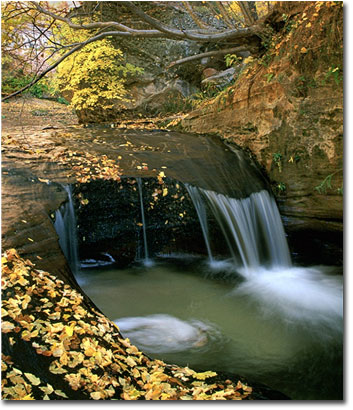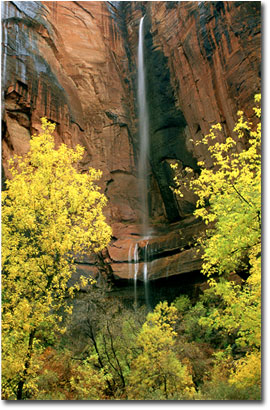Photo Itinerary...
Autumn in Zion
Text and photography copyright Jim Greenwood
All rights reserved.
A visit to Zion National Park at any time of year has high potential be an enjoyable and rewarding experience. The park has a great deal to offer regardless of the season. I have spent time there on several occasions during spring and late summer, and have never been disappointed. Last year I made my first trip timed specifically to experience peak autumn foliage. Afterwards, I had to admit that autumn in Zion definitely has its advantages, and is probably the ideal time of year to visit the park.
 As is usually the case anywhere, the timing and intensity and duration of peak autumn foliage in Zion will be influenced by both recent and long-term environmental and weather conditions. Much of the southwest, including Zion, has been enduring a fairly severe drought for the past several years. As a result, autumn colors have generally not been as spectacular recently as in years with more normal precipitation levels. Of course, elevation also plays a role. Elevations within park boundaries vary between approximately 4000 and 9000 feet. I took a hike a few years ago along the Wildcat Canyon Trail in the Kolob Plateau region at about 7800 feet in late September, and the aspens and maples were already turning. However, prime time at the lowest elevations, which includes Zion Canyon along the Virgin River, is most likely to occur in early November.
As is usually the case anywhere, the timing and intensity and duration of peak autumn foliage in Zion will be influenced by both recent and long-term environmental and weather conditions. Much of the southwest, including Zion, has been enduring a fairly severe drought for the past several years. As a result, autumn colors have generally not been as spectacular recently as in years with more normal precipitation levels. Of course, elevation also plays a role. Elevations within park boundaries vary between approximately 4000 and 9000 feet. I took a hike a few years ago along the Wildcat Canyon Trail in the Kolob Plateau region at about 7800 feet in late September, and the aspens and maples were already turning. However, prime time at the lowest elevations, which includes Zion Canyon along the Virgin River, is most likely to occur in early November.
The photograph to the right was taken while enjoying a very pleasant hike to the Subway during the final week of October last year. This is one of the premier hikes in Zion. It is an environmentally sensitive limited access area and hikers must obtain a permit from the visitors center. The complete one-way route, which starts at the Wildcat Canyon Trailhead and drops down Russell Gulch to the Left Fork of North Creek, contains a technical portion which requires canyoneering skills including rappelling and swimming to negotiate a slot canyon. However, most people (including myself) opt for hiking only the non-technical portion of the route beginning at the Left Fork Trailhead on Kolob Terrace Road and proceeding steeply down into the canyon formed by the Left Fork of North Creek and then following the creek upstream to the Subway. For those not familiar with the Subway, it is a spectacular tunnel-like geologic formation through which the Left Fork flows. It is the turn-around point of the non-technical hike. This is a moderate to strenuous hike depending on one’s abilities, totaling about nine miles from the lower trailhead to the Subway and back. I can distinctly recall the excitement I felt on that occasion while I stood on the canyon rim a short distance from the trailhead and gazed down on a ribbon of yellow foliage that highlighted the path of the creek 400 feet below. I was sure it would be a memorable day. The autumn color had probably not quite yet reached its peak, but it was still very nice. My efforts behind the camera that day were rewarded with three particularly excellent compositions. This picturesque little cascade can be easily found just before reaching the Subway.
 By November, visitation in Zion is significantly less than the high numbers received in summer and early autumn. While summertime temperatures in Zion frequently exceed 100°F, and occasionally even reach 110-115°F, by the beginning of November the normal daytime high temperature has dropped to a very comfortable 70°F or so. The normal overnight low temperature will dip to about 40°F by this time of year, making for some invigorating sunrise photography sessions. In addition, although I understand and accept the need for a shuttle program in Zion Canyon during the peak visitation period from April through October, another advantage enjoyed by November is that the shuttle has been discontinued for the season and private vehicle access is permitted on the Zion Canyon Scenic Drive.
By November, visitation in Zion is significantly less than the high numbers received in summer and early autumn. While summertime temperatures in Zion frequently exceed 100°F, and occasionally even reach 110-115°F, by the beginning of November the normal daytime high temperature has dropped to a very comfortable 70°F or so. The normal overnight low temperature will dip to about 40°F by this time of year, making for some invigorating sunrise photography sessions. In addition, although I understand and accept the need for a shuttle program in Zion Canyon during the peak visitation period from April through October, another advantage enjoyed by November is that the shuttle has been discontinued for the season and private vehicle access is permitted on the Zion Canyon Scenic Drive.
As mentioned above, the timing of peak color will vary from year to year, although the general rule of thumb seems to be that it will occur around the second week of November in Zion Canyon. I arrived at this conclusion gradually and very unscientifically by talking to park rangers, local residents and others in the know. This prediction seemed to be accurate last year. When I arrived on October 21st, there was only a little color in Zion Canyon. But when I took the hike to the Subway two days later, there was quite a bit more color along the creek, although it hadn’t peaked yet. The elevation at the bottom of the 400 foot decent to the creek is about 4700 feet, and the elevation at the Subway is about 5200 feet. I left the Zion area a few days later, and then returned on November 4th. By that time the color in Zion Canyon had improved significantly, and continued to improve during the following week.
Most likely not by coincidence, well-known landscape photographer David Muench was conducting a workshop in Zion last year at just this time, in which I was able to participate (see my article in the March 2003 issue of NPN titled Workshop Impressions). David was assisted by current NPN member Rod Barbee. The photograph above on the left was taken during one of the workshop’s field sessions. There were frequent moderate rain showers occurring that day, but there were also enough breaks in the rain to allow some opportunities for photography. The location here is the Temple of Sinawava near the end of the Zion Canyon Scenic Drive, where an ephemeral waterfall is framed strikingly by a pair of cottonwoods in their full autumn glory. The rain unquestionably enhanced the overall experience that day, making for some especially enjoyable and productive photography in the company of the workshop leaders and participants.
 As for this last photograph, needless to say, this is the Watchman as viewed from the Utah Highway 9 bridge over the Virgin River. Of course, I had my official valid Utah Icon License on my person and displayed in full view. Honestly, while I had made previous attempts to photograph the Watchman from locations further downstream, up to that point I had never been inclined to shoot the scene from the bridge. But I figured that if David Muench was willing to spend time photographing this Zion icon from this … popular … vantage point (as indeed he did during the day prior to the start of the workshop), then I certainly could no longer justify avoiding it myself. So I made a point to stop there one evening later that week and hoped for the best. Of course I arrived early enough to stake my claim to the perfect spot on the bridge, the one spot which nobody else had ever shot from, the one spot which would provide the perfect arrangement of elements throughout the composition. This image was my best result. Good light on the cliffs in the background, some clouds in the sky with good color to add interest, the sweeping curve of the Virgin River leading into the scene, cottonwoods providing some subdued yet appealing autumn foliage and contrasting tones in the foreground, what more could I ask for.
As for this last photograph, needless to say, this is the Watchman as viewed from the Utah Highway 9 bridge over the Virgin River. Of course, I had my official valid Utah Icon License on my person and displayed in full view. Honestly, while I had made previous attempts to photograph the Watchman from locations further downstream, up to that point I had never been inclined to shoot the scene from the bridge. But I figured that if David Muench was willing to spend time photographing this Zion icon from this … popular … vantage point (as indeed he did during the day prior to the start of the workshop), then I certainly could no longer justify avoiding it myself. So I made a point to stop there one evening later that week and hoped for the best. Of course I arrived early enough to stake my claim to the perfect spot on the bridge, the one spot which nobody else had ever shot from, the one spot which would provide the perfect arrangement of elements throughout the composition. This image was my best result. Good light on the cliffs in the background, some clouds in the sky with good color to add interest, the sweeping curve of the Virgin River leading into the scene, cottonwoods providing some subdued yet appealing autumn foliage and contrasting tones in the foreground, what more could I ask for.
Visit these National Park Service web pages for more information:
Jim Greenwood - NPN 013
Comments on NPN nature photography articles? Send them to the editor.


| 


